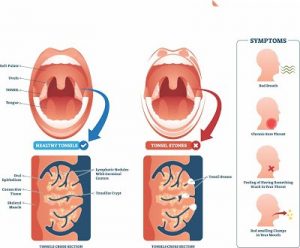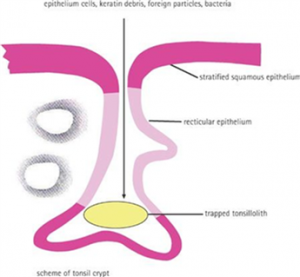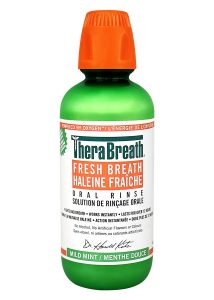ENG 301-assignment 1:3
Writing group: Team Typephoon
Student: Brenda Martinez
Peer review post link: https://blogs.ubc.ca/engl301-99a-2019wa/2019/09/27/peer-review-of-definition-tonsillolith/
Original Assignment 1:3 post link: https://blogs.ubc.ca/engl301-99a-2019wa/2019/09/23/assignment-13-definitions-3/
Hi everyone!
This is my revised assignment, I will discuss my experience with editing, peer review process, and applying the recommendations to this assignment in my reflection post.
Introduction and Objectives: This assignment is written with the purpose of presenting a complex term used within my profession. As a dental hygienist, I provide preventative oral health services with a focus on head and neck anatomy. Educating patients on various aspects of their oral health is important to enhance their overall wellness. In this assignment I will be introducing you to a common condition that I see often in my practice. I will be defining the term in a parenthetical definition, a sentence definition, and I will provide an expanded definition to further explain the term.
Reading situation: A patient presents to their routine dental hygiene visit; I review their medical history. The patient reports recent symptoms of offensive bad breath, sore throat, ear aches, and, difficulty swallowing. I notice that the patient has a history of seasonal allergies, and this patient is experiencing post nasal drip. Aside from seasonal allergies, the patient is in good health. The main concern is their bad breath. Upon a visual clinical exam of the oral cavity and surrounding tissues, I conclude that the patient is suffering from tonsilloliths.
Parenthetical definition: Tonsilloliths, (tonsil stones), are not harmful as much as they are unpleasant.
Sentence definition: Tonsilloliths are calcified stones made up of mucus, food debris, and bacteria encrusted in the crevices of the tonsils.
Expanded definition of ‘Tonsilloliths’
Are tonsilloliths potential causes of bad breath? Patients often ask dental health care providers questions about their oral health conditions, and cause factors of halitosis (bad breath). Aside from the common and more obvious reasons, such as, poor oral hygiene, periodontal (gum) disease, tooth decay, and systemic health conditions, tonsilloliths (tonsil stones encrusted in the tonsillar crevices) are often a common condition that is overlooked. A patient could have impeccable oral hygiene and still suffer from tonsilloliths. I will further explain the condition and preventative measures of tonsilloliths.
What are tonsilloliths?
Tonsilloliths are calcified tonsil stones made up of bacteria and mucus. When the tonsils are inflamed due to conditions like recurrent tonsillitis or seasonal allergies, the crevices are enlarged in these porous glands. Biofilm, food debris and mucus accumulate in the notches at the back of the throat and tonsils. The bacteria harden over time and that is why it is referred to as a stone. Tonsilloliths can be of various degrees of condition, mild, moderate, and even severe in rare cases. The stones emit a foul smell due to the breakdown of acids from the putrefying plaque bacteria. Figure 1 and 2 are examples of the embedded tonsilloliths in the tonsillar anatomy.


Figure 1 Tonsillolith symptoms
Figure 2 Tonsillolith in crevice
Source 1: Adapted from ENT conditions blog
https://www.entsurgeon-london.co.uk/2019/05/tonsil-stones-or-tonsillolith.html
Source 2: Adapted from British Dental Journal
https://www.nature.com/articles/bdj.2007.1106
Who is at risk of tonsilloliths?
This condition can affect anyone to a certain degree, but some patients suffer with this condition more frequently. It can cause tonsillitis, sore throat, neck pain, but most detrimentally tonsilloliths are a cause of chronic bad breath. Often a nuisance, but due to the bad breath associated with this condition, it can impact individuals socially.
How to prevent tonsilloliths?
Maintaining good oral hygiene, including tongue scrapping, and rinsing with mouthwash can help reduce oral bacteria, thereby preventing tonsilloliths. Rinsing with salt and warm water for gargling can help dislodge the stones. Therabreath, pictured in figure 3, medicated oral rinse has been proven to greatly reduce the recurrence of tonsilloliths in chronic conditions.

Figure 3 TheraBreath Oral Rinse
Source 3: Adapted from TheraBeath Canada
https://www.therabreathcanada.com/products
When to seek help?
Patients who suffer frequently from tonsilloliths could be impacted at various degrees. Often, the condition could improve with at home care, and over the counter products. If this condition is compromising their well being, a referral could be made to an ENT, (ear, nose, and throat specialist), for an evaluation. Specialists can help with this condition by using laser therapy, and potentially surgically removing the tonsils.
Literature Cited
Canadian Journal of Dental Hygiene, v45n4-November 2011, pg 223-228 Halitosis from tonsilloliths: Literature review for oral healthcare providers. Myrna RF. DeAssis-Soares, DipDH, BDH; and Peggy J. Maillet, DipDH, BA, Med [online] Available at: https://www.cdha.ca/pdfs/Profession/Journal/v45n4.pdf [Accessed 23 Sep. 2019].
‘Tonsil Stones or Tonsilloliths’ ENT blog [online] Available at: https://www.entsurgeon-london.co.uk/2019/05/tonsil-stones-or-tonsillolith.html [Accessed 23 Sep. 2019].
figure 1 https://www.nature.com/articles/bdj.2007.1106
figure 2 https://www.entsurgeon-london.co.uk/2019/05/tonsil-stones-or-tonsillolith.html
Leave a Reply